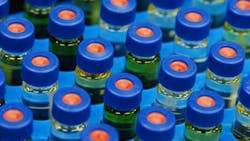Study demonstrates faster PFAS test method
A new study demonstrates a lab-based method to detect traces of per- and polyfluoroalkyl substances (PFAS) from water, soil and food packaging material samples in just three minutes or less, according to a press release from the New Jersey Institute of Technology.
The method could be one of the fastest and most sensitive approaches yet for detecting toxic PFAS in water samples. The study’s results are in Elsevier’s Journal of Hazardous Materials.
“There are thousands of different species of PFAS, but we’ve yet to understand the extent of their distribution in our environment because the current testing methods are costly and time-consuming, taking hours for sample preparation and analysis in some cases,” said Hao Chen, the study’s corresponding author and NJIT chemistry professor. “What our study demonstrates is a much faster, sensitive and versatile method that can monitor our drinking water, land and consumer products for contamination in minutes.”
Chen and colleagues say the new method — involving an ionization technique for analyzing the molecular composition of sample materials called paper spray mass spectrometry (PS-MS) — is 10-100 times more sensitive than the current standard technique for PFAS testing, liquid chromatography/mass spectrometry.
“PFAS can be ionized and rapidly detected by a high-resolution mass spectrometer, which gives a clear view of each PFAS species present and the degree of contamination down to a parts-per-trillion (ppt) level,” explained Chen. “For more complex matrices like soil, we’ve applied a related method called desalting paper spray mass spectrometry (DPS-MS) that washes away salts which normally suppress the ion signal of PFAS. Together, they greatly improve our ability to detect these compounds.”
“Our limit of detection for PFAS is roughly 1ppt. For context, this amount has been likened to a drop of water in 20 Olympic-sized swimming pools,” added Md Tanim-Al Hassan, the paper’s first author and Ph.D. chemistry student at NJIT.
In tests, the team was able to detect PFAS in one minute or less by analyzing pieces of various food packaging materials directly, including microwave popcorn paper, instant noodle boxes, as well as fry and burger packaging from two multinational fast food restaurant chains.
The analysis revealed traces of 11 different PFAS molecules — including common types that have been linked to increased cancer risk and immune system suppression, such PFOA (Perfluorooctanoic Acid) and PFOS (Perfluorooctanesulfonic acid).
In their water analysis, the team detected traces of PFOA in samples of local tap water in under two minutes, while finding no traces of PFAS in samples taken from the university’s filtered fountain water.
“The EPA has already proposed to establish maximum contamination levels (MCLs) for six PFAS in drinking water nationwide, and PFOA and PFOS are among them,” said Mengyan Li, study co-author and NJIT associate professor of environmental sciences. “This analytical method could facilitate more intensive screenings for toxic PFAS that may be needed under such a proposal to protect the safety of our water supply.”
Using DPS-MS, the team also identified two species of PFAS from as little as 40mg of soil in under three minutes.
